“The Finns have a very unique and special strength in that they know who they are. And who they are is directly rooted in human rights and the rule of law, in a lot of things that Russia, right now, is not,” Willard said. “There is a strong sense of what it means to be Finnish … that is a super power.”
Not all nations have the type of narrative to fall back on that Finland does.
The small and largely homogenous country consistently ranks at or near the top of almost every index – happiness, press freedom, gender equality, social justice, transparency and education – making it difficult for external actors to find fissures within society to crowbar open and exploit.
Finland also has long tradition of reading – its 5.5 million people borrow close to 68 million books a year and it just spent $110 million on a state-of-the-art library, referred to lovingly as “Helsinki’s living room.” Finland has the highest PISA score for reading performance in the EU.
Ruutisbyroo CNN/”Tomorrown” pohjanoteeraus ”Suomen trollisodasta”…
Suomessa on maailman tyhmin ja tietämättömin kansa?
Muuta johtopäätöstä ei juurikaan voi vetää siitä, kuinka totaalisesti Suomen meedia valehtelee kaiken – JA SAMAAN AIKAAN SIIHEN USKOTAAN MAAILMAN ENITEN Reutersin meediatutkimuksen mukaan!!!
Näyttää siltä, että kaikki tämä pölhö- lallatus muka ”Suomen paremmuuk- sista” on siis Ruutistoimisto CNN:n (Hillary, Obina ym.) INFOSOTAA!!! Kis- san pissat Suomi ole missään noista missään ”kärjessä” – KAIKKEIN VIIMEKSI TIETEESSÄ JA KASVATUKSESSA!
Näyttää edelleen siltä, että tämä skitsoilu EI OLE TARKOITETTU ENSISIJAISESTI SUOMALAISILLE vaan maihin, joissa Suomesta ei tiedetä mitään! Tai se ainakin yritetään levittää niihin,nytkun se Suomessa vain kusee…
Siltä kannalta tämä kuulu samaan sarjaan kuin parinkymmene vuoden takainen joka paikan ”Uuden Sellannin malli” ja vähän myöhempi ”IRLANNIN EU-talousihme”, joka johti katastrofiin, josta EU pelasti – se joka oli sen aiheuttanutkin!
https://edition.cnn.com/interactive/2019/05/europe/finland-fake-news-intl/
Finland is winning the war on fake news. What it’s learned may be crucial to Western democracy
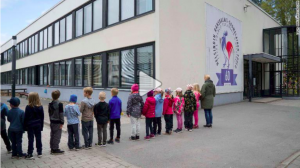
https://edition.cnn.com/interactive/2019/05/europe/finland-fake-news-intl/
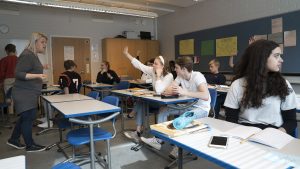
Students in Valentina Uitto’s social studies class research the issues at play in the upcoming EU elections as part of their critical thinking curriculum.
The school recently partnered with Finnish fact-checking agency Faktabaari (FactBar) to develop a digital literacy “toolkit” for elementary to high school students learning about the EU elections. It was presented to the bloc’s expert group on media literacy and has been shared among member states.
The exercises include examining claims found in YouTube videos and social media posts, comparing media bias in an array of different “clickbait” articles, probing how misinformation preys on readers’ emotions, and even getting students to try their hand at writing fake news stories themselves.
“What we want our students to do is … before they like or share in the social media they think twice – who has written this? Where has it been published? Can I find the same information from another source?” Kari Kivinen, director of Helsinki French-Finnish School and former secretary-general of the European Schools, told CNN.
He cautioned that it is a balancing act trying to make sure skepticism doesn’t give way to cynicism in students.
“It’s very annoying having to fact check everything, not being able to trust anything … or anyone on the internet,” said 15-year-old Tatu Tukiainen, one of the students in Uitto’s class. “I think we should try to put a stop to that.”
In the school library, Alexander Shemeikka, 17, and Gabrielle Bagula, 18, are watching YouTube videos together on an iPhone and chatting about other social platforms where they get their news: Instagram, Snapchat, Reddit and Twitter but, notably, not Facebook – “that’s for old people.”
“The word ‘fake news’ is thrown around very often,” Shemeikka said, explaining that when their friends share dubious memes or far-fetched articles online he always asks for the source. “You can never be too sure,” Bagula agreed.
That’s exactly the type of conversation that Kivinen hopes to cultivate outside of the classroom.
“What we have been developing here – combining fact-checking with the critical thinking and voter literacy – is something we have seen that there is an interest in outside Finland,” Kivinen said.
But Kivinen isn’t sure that this approach could serve as a template for schools elsewhere. “In the end … it’s difficult to export democracy,” he added.
The ‘superpower’ of being Finnish
It may be difficult to export democracy, but it is easy to import experts, which is precisely what Finland did in 2016 to combat what it saw as a rise in disinformation emanating from accounts linked to its neighbor to the east.
“They knew that the Kremlin was messing with Finnish politics, but they didn’t have a context with which to interpret that. They were wondering if this meant they [Russia] would invade, was this war?” Jed Willard, di- rector of the Franklin Delano Roosevelt Center for Global Engagement at Harvard University, who was hired by Finland to train state officials to spot and then hit back at fake news, told CNN.
Russia maintains that it has not and does not interfere in the domestic politics of other countries.
Behind closed doors, Willard’s workshops largely focused on one thing: developing a strong national narrative, rather than trying to debunk false claims.
HM: Kaikki tämä pölhölallatus muka ”Suomen paremmuuksista” on siis Ruutistoimisto CNN:n (Hillary, Obina ym.) INFOSOTAA!!!
Kissan pissat Suomi ole missään noista missään ”kärjessä” – KAIKKEIN VIIMEKSI TIETEESSÄ JA KASVATUKSESSA!
HM: Eduskunnan YLE:n Jeessika Aro pitää Googlea, Facebookia, Twitteriä ja Youtubeakin ”RYSSÄN TROLLEINA”!!!!
Polluting the internet?
But some argue that simply teaching media literacy and critical thinking isn’t enough — more must be done on the part of social media companies to stop the spread of disinformation.
“Facebook, Twitter, Google/YouTube … who are enablers of Russian trolls … they really should be regulated,” said Jessikka Aro, a journalist with Finland’s public broadcaster YLE, who has faced a barrage of abuse for her work investigating Russian interference, long before it was linked to the 2016 US elections.
“Just like any polluting companies or factories should be and are alrea- dy regulated, for polluting the air and the forests, the waters, these companies are polluting the minds of people. So, they also have to pay for it and take responsibility for it.”
Facebook,Twitter and Google,which are all signatories to the European Commission’s code of practice against disinformation, told CNN that they have taken steps ahead of the EU elections to increase transpa- rency on their platforms, including making EU-specific political adver- tisement libraries publicly available, working with third-party fact-checkers to identify misleading election-related content, and cracking down on fake accounts. ”
HM: EUROPEAN COMMISSION WITH ITS IN FINLAND FABRICA- TED FICTIUOUS ”94 MILLION VICTIMS OF COMMUNISM” IS PERHAPS THE MOST FALSE HATE SPEECH ASSHOLE IN THE HISTORY!!!
https://hameemmias.vuodatus.net/lue/2017/08/helvetin-eu-havylta-on-katkaistu-hanta
HELVETIN EU, HÄVYLTÄ ON KATKAISTU HÄNTÄ!
.
Kautta EU:n ollaan nyt säätämässä massiivista propaganda ja sensuurilakia. Katsokaa mietintö linkistä.
.
.
MIETINTÖ
.
14. lokakuuta 2016
.
PE 582.060v03-00 A8-0290/2016
.
EU:n strategisesta viestinnästä kolmansien osapuolten levittämän EU:n vastaisen propagandan torjumiseksi
.
(2016/2030(INI))
.
Ulkoasiainvaliokunta
.
Esittelijä: Anna Elżbieta Fotyga
.
EUROOPAN PARLAMENTIN PÄÄTÖSLAUSELMAESITYS
.
LOPULLISEN ÄÄNESTYKSEN TULOSASIASTA VASTAAVASSA VALIOKUNNASSA
.
.
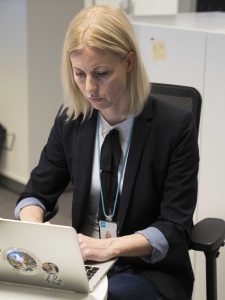
.
Jessikka Aro scrolls through her Twitter mentions, pointing out the type of trolling and abuse she has faced online as a result of her investigations.
.
Aro’s first open-source investigation back in 2014 looked at how Russia-linked disinformation campaigns impacted Finns. ”
.
HM: Huom! Ruutisbyroolla on SUOMENKIELINEN linkki – vaikka englan- ninkielisiäkin varmasti löytyisi – jotta sikäläiset lukijat eivät heti huomaa, kuinka patatyhmä asia on…
” “Many Finns told me that they have witnessed these activities, but that it was only merely new digital technology for the old fashioned, old school Soviet Union propaganda, which has always existed and that Finns have been aware of,” Aro said. “So, they could avoid the trolls.”
The probe also made her the target of a relentless smear campaign, accused of being a CIA operative, a secret assistant to NATO, a drug dealer and deranged Russophobe.
Aro received some respite when, last year, the Helsinki District Court handed harsh sentences to two pro-Putin activists on charges of defamation – Ilja Janitskin, a Finn of Russian descent who ran the anti-immigrant, pro-Russia website MV-Lehti, and Johan Backman, a self-declared “human rights activist” and frequent guest on the Russian state-run news outlet RT.
It was the first time that an EU country had convicted those responsible for disinformation campaigns, drawing a line in the sand between extreme hate speech and the pretense of free speech. ”
HM: … Totaa… Onkohan minusta kukaan kertonut mitään … kun YLE on noteerannut ”kolmen pahimman joukkoon” … (tai sitten pahimmaksi YKSITYISHENKILÖKSI) ilman että olen tähän asti tiennyt asiasta mitään … Jessikö???
MUTTA MIKÄ ON KAIKEN TARKOITUS???!
ONKO SE ”RYSSÄN TUHO”??!! (On tietysti joillekuille, kun ”dalmatia” on tarpeeksi pitkällä… ja että NATO ”jakaisi läntisen Venäjän yksityistiloiksi suomalaisille…)
MUTTA YHDEN MUUN VASTAUKSEN VASTAUSKEN ANTAAKIN YLE/CNN:
Tavoite on IKUINEN SUOJATYÖPAIKKA HAISTASTAPASKANTOIMITTAJA-LALLAREILLE!!!
Vaikka luulisi, niin tämä skitsoilu EI OLE TARKOITETTU ENSISIJAISESTI SUOMALAISILLE vaan maihin, joissa Suomesta ei tiedetä mitään! Tai se ainakin yritetään levittää niihin,nytkun se Suomessa vain kusee…
Siltä kannalta tämä kuuluj samaan sarjaan kuin parinkymmene vuoden takainen joka paikan ”Uuden Sellannin malli” ja vähän myöhempi ”IRLANNIN EU-talousihme”, joka johti katastrofiin, josta EU pelasti – se joka oli sen aiheuttanutkin!
” A never-ending game
Perhaps the biggest sign that Finland is winning the war on fake news is the fact that other countries are seeking to copy its blueprint. Representatives from a slew of EU states, along with Singapore, have come to learn from Finland’s approach to the problem.
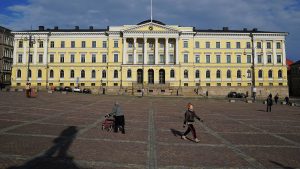
The scene outside the Prime Minister’s Office in Helsinki. Since 2016, government officials have trained over 10,000 Finns how to spot fake news.
The race is on to figure out a fix after authorities linked Russian groups to misinformation campaigns targeting Catalonia’s independence referendum and Brexit, as well as recent votes in France and Germany. Germany has already put a law in place to fine tech platforms that fail to remove “obviously illegal” hate speech, while France passed a law last year that bans fake news on the internet during election campaigns. Some critics have argued that both pieces of legislation jeopardize free speech. Russia denied interference in all of these instances.
Finland’s strategy was on public display ahead of last month’s national elections, in an advertising campaign that ran under the slogan “Finland has the world’s best elections – think about why” and encouraged citizens to think about fake news. Officials didn’t see any evidence of Russian interference in the vote, which Toivanen says may be a sign that trolls have stopped thinking of the Finnish electorate as a soft target.
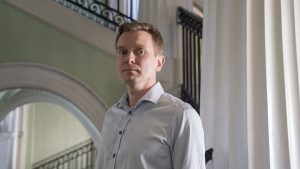
Jussi Toivanen, who has traveled the country to train Finns, at his office in Helsinki.
(A bullshit-scientist´s/radactor´s look: olnly to lie more and more…
https://www.youtube.com/watch?v=oI-4FvaUUvg )
Haistapaskantieteilijäm katse…
“A couple of years ago, one of my colleagues said that he thought Fin- land has won the first round countering foreign-led hostile information activities. But even though Finland has been quite successful, I don’t think that there are any first, second or third rounds, instead, this is an ongoing game,” Toivanen said.
“It’s going to be much more challenging for us to counter these kinds of activities in the future. And we need to be ready for that.”
Related links
Credits
- Photographer: Eliza Mackintosh
- Digital design and development: Henrik Pettersson, Mark Oliver and Byron Manley
Voi Vladi minkä teit…
https://www.youtube.com/watch?v=oI-4FvaUUvg
”Hörhöilyn takana näyttää olevan myös kansainvälinen järjestö ”World Economic Forum”:
https://www.weforum.org/agenda/2019/03/finland-is-the-world-s-happiest-country-again/
Finland is the world’s happiest country – again

The world is getting used to being told that Scandinavian countries are among the best places to live. The release of the 2019 World Happiness Report again confirms that impression with four Nordic countries in the top five happiest nations.
Finland, which headed the table last year, came top again, followed by Denmark, Norway (top in 2017) and Iceland. The Netherlands joined them in the top five. Switzerland, Sweden, New Zealand, Canada and Austria completed the top 10.
The US only made it to number 19, down from 18 last year. The UK was placed 15th, one ahead of Ireland with Pakistan ranked 67 and India 140 out of 156 nations surveyed. Two nations riven by civil strife, South Sudan and the Central African Republic were ranked as the least happy.
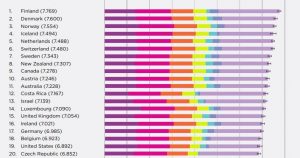
It’s easy to see how civil war and insurgencies can bring misery to people, but what really makes a happy nation? The report’s authors insist it’s not just about money, even though the top 10 are all affluent countries.
Money can’t buy you happiness
The survey, conducted by Gallup, uses a three-year rolling average of survey responses around six factors: GDP per capita; social support; life expectancy; freedom to make life choices; generosity; and corruption levels. Finland scores well on all factors but particularly strongly on generosity.
The authors say that helping others makes you feel better, but only if you choose to do it. Almost half of Finns donate regularly to charity and almost a third said they had given up time to volunteer for a charity in the previous month.
The Copenhagen-based Happiness Research Institute points out that Finland tops the happiness list despite not having the highest GDP of the Nordic countries. It is the country’s social safety net combined with personal freedom and a good work-life balance that gives it the edge.
The OECD’s Better Life Index suggests that Finland’s sense of wellbeing may also be down to a feeling of personal safety in a troubled world. Finns feel good about their environment, sense of community and public services and education, but they worry about jobs and housing.
As if to prove that you cannot buy happiness, the US sits at number 19, one place down from last year. Although it has the world’s highest GDP, economist Jeffrey Sachs, one of the report’s authors, said worsening health conditions and declines in social trust and trust in government were making Americans less happy.
Any wellbeing benefits from rising incomes in the US were being offset by growing addictions to gambling, social media use, video gaming, shopping and consuming unhealthy foods which were causing unhappiness and even depression, he said.
Have you read?
Governments can make you happy
The World Happiness Report says countries which improve civic engagement by making their government more representative will be happier. Happier populations have higher voter turnout, while political division and declining social trust reduce happiness.
Leading the nations recording the strongest growth in happiness this year was Benin, which has enjoyed a period of stability. The West African nation is ranked 102 in the overall happiness table followed by Nicaragua, Bulgaria, Latvia and Togo. The five sharpest declines were in Venezuela, Syria, Botswana, India and Yemen.
Benin has experienced steady GDP growth in recent years with life expectancy improving. It is part of a welcome trend across sub-Saharan Africa led by the more politically stable nations. Conversely, Venezuela’s societal woes and Syria’s civil war have coincided with plummeting happiness levels.
… ”
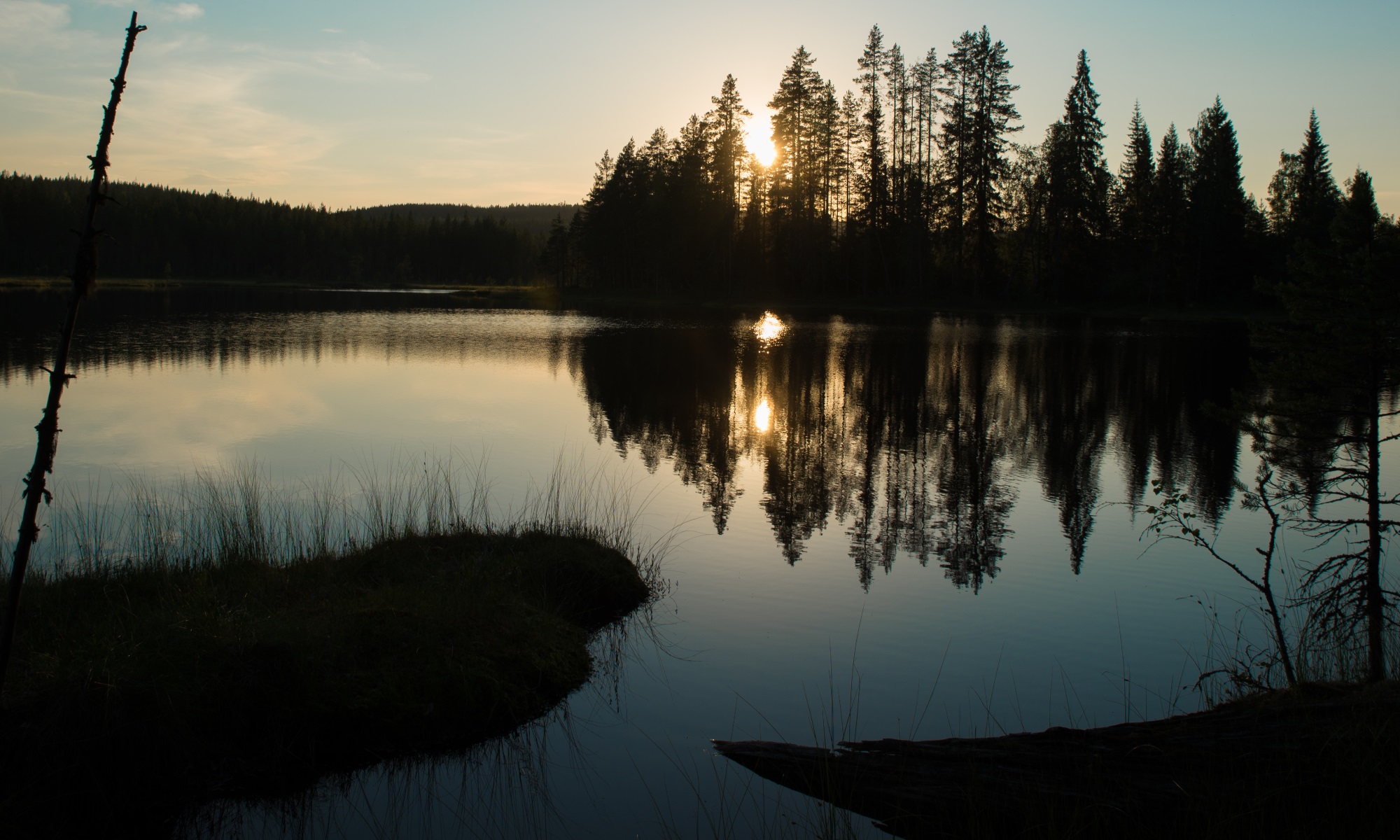

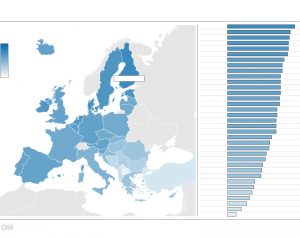
”Näyttää siltä, että kaikki tämä pölhölallatus muka ”Suomen paremmuuksista” on siis Ruutistoimisto CNN:n (Hillary, Obina ym.) INFOSOTAA!!! Kissan pissat Suomi ole missään noista missään ”kärjessä” – KAIKKEIN VIIMEKSI TIETEESSÄ JA KASVATUKSESSA”
———————————————————-
Meistä älykkäimmät kuitenkin tajuavat, että kaikki tuo on menetetty, jos soroslaisia teitä kuljemme.
Suomessa puuttuu mediakriittisyys jos on tähän uutiseen luottaminen.
Valitettavasti se maailman paras maa eli neukkula kaatui omaan parhauteensa.
Nyt lähinnä lienee Venezuelan onnela.
Suomalaiset ovat pisatutkimuksen kärjessä.
Suomessa on maailman paras eläkejärjestelmä.
Suomessa asuvat maailman onnellisimmat ihmiset.
Olen aina suhtautunut nuivasti Suomen liikakehumiseen. Kyllähän Suomessa on monet asiat hyvin: infra toimii, koulutus on tehokasta ja suhthalpaa, vanhuksista pidetään huolta ja sosiaaliturva on melko hyvä.
On myös epäkohtia kuten leipäjonot, köyhyysrajan alapuolella elävien ihmisten määrä on suuri, liian suuri, nämä päällimmäisenä.
Suomi on suhtkoht hyvä maa elää ja asua, mutta liikasuitsutuksesta tulee mieleen: Höystävät, olemme EU:n ehkä hölmöin mallioppilas ja eliitti osaa höystää hölmöjä ja turha luullakaan, ettei EU:n ulkoopuolinen eliitti vetäisi yhtä köyttä EU-eliitin kanssa.
Valuuttakeinottelija George Soros on outo lintu. Toisinaan olen epäillyt, että hän purkaa maailmantuskaansa miljardiensa avulla. Toisinaan olen epäillyt, että hän haluaa upottaa lännen, jotta islamistit ja kristityt tuhoaisivat toinen toisensa ja Herran valittu kansa pääsisi maailman valtiaaksi. Mene ja tiedä.
Tuolla hörhölällä on suhteita USA:an, MUUTA FIRMAAN EIKÄ VALTIOVALTAAN!